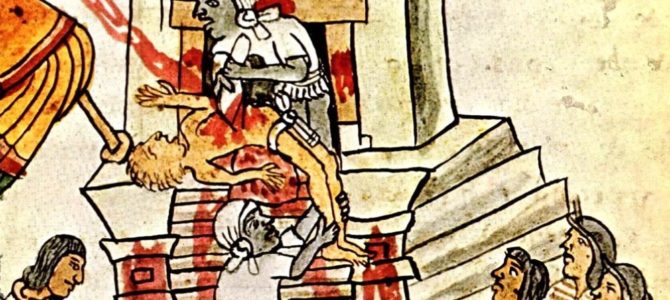
The New York Times officially announced its new 1619 Project to “to reframe the country’s history, understanding 1619 as our true founding, and placing the consequences of slavery and the contributions of black Americans at the very center of the story we tell ourselves about who we are.” Constantly now, Americans are called upon to reflect on European villains and indigenous victims. However, the story of European civilization reaching the North American continent did not begin with the first arrival of slave ships at Jamestown in 1619.
Let’s take a brief recess from the 1619 Project to explore another project. Call it the “1519 Project.” A full century before The New York Times’ proposed re-dating of the American founding and 2,200 miles southwest of Jamestown, European contact sparked a native uprising against a gruesome cult of cannibalism and mass murder.
Graphically described in the 1855 book, “Makers of History: Hernando Cortez,” John S.C. Abbott paints a picture of desperation for a tiny band of Spanish soldiers and their native allies. Next year marks the 500th anniversary of the Battle of the Dismal Night, where an initially successful Cortez was nearly crushed by superior Aztec forces.
After being driven out of the Aztec capital of Tenochtitlan, Cortez led a frantic, fighting retreat through the mountain passes. Cortez lost all his gunpowder and cannons while fleeing through the water surrounding the capital. Only 12 horses remained of his entire cavalry. Cortez told his historian, “of the twenty-four horses that remained to us, there was not one that could move briskly, nor a horseman able to raise his arm, nor a foot-soldier unhurt who could make any effort.”
As Cortez retreated, he left intact the Aztec system of ritualistic mass murder. In his book, Abbott details the horrific acts of the Aztecs:
At times, in the case of prisoners taken in war, the most horrid tortures were practiced before the bloody rite was terminated. When the gods seemed to frown, in dearth, or pestilence, or famine, large numbers of children were frequently offered in sacrifice. Thus the temples of Mexico were ever clotted with blood. Still more revolting is the well-authenticated fact that the body of the wretched victim thus sacrificed was often served up as a banquet, and was eaten with every accompaniment of festive rejoicing. It is estimated that from thirty to fifty thousand thus perished every year upon the altars of ancient Mexico.
The Aztecs brutal system depended on a steady supply of prisoners of war and human children collected from the empire’s subjects as “taxes.” The scale of the murder one could find in just a single outlying Aztec city was astounding. Abbot relays, “they witnessed the most appalling indications of the horrid atrocities of pagan idolatry. They found, piled in order, as they judged, one hundred thousand skulls of human victims who had been offered in sacrifice to their gods.”
Fear kept the blood running down the steps of the Aztec temples until, in 1519, Cortez landed and challenged the evil that had until then been unchallengeable. Before long, tens of thousands of natives flocked to join Cortez’s unwitting liberation movement. For a short while, he captured the fortified Aztec capital until being driven out by far superior forces.
As he desperately tried to lead his men to safety, Cortez’s interpreter translated the taunts of the harassing Aztec forces: “Hurry along, robbers, hurry along; you will soon meet with the vengeance due to your crimes.” Then “the significance of this threat was soon made manifest. As the Spaniards were emerging from a narrow pass among the cliffs … they came suddenly upon an extended plain. Here to their amazement, they found an enormous army” arrayed against the few hundred Spaniards who had just limped into a final ambush. Abbot describes the Aztec forces as “a living ocean of armed men,” numbering 200,000 strong.
Cornered, and out of options, Cortez decided to lead his men into a final, suicidal charge against the overwhelming odds. Cortez led his rag-tag forces in a frontal assault, mustering all the speed he could out of his wounded, exhausted, and starving forces.
Before the Aztecs could drown them with superior numbers, Cortez’s forces reached the Aztec’s blood-red banner and he seized it. Cortez had fought enough battles with the Aztecs to recognize the banner was a sacred symbol of Aztec authority. With their banner gone, the Aztecs lost morale and panicked, breaking into disorganized chaos. With the chain of command destroyed, Cortez seized one of the most audacious military victories in human history.
Cortez later recaptured the capital city. While Abbott acknowledges that human rights among the Spaniards of the 16th century “were but feebly discerned,” in contrast to the Aztecs, Cortez “treated all the prisoners he took very kindly, and liberated them with presents.” Cortez ended the grotesque practice of human sacrifice and, according to Abbott, “treated the vanquished natives with great courtesy and kindness.”
Cortez was no saint. He lusted after women, gold, and adventure—so much he missed his first chance at battle due to injuries sustained after falling from a great height trying to sneak into the bedroom of a villager’s daughter. As Abbott concedes, his “love of plunder was a latent motive omnipotent in his soul, and he saw undreamed of wealth lavishly spread before him.”
Cortez will never satisfy a 21st century standard of human rights, and may not even be an exemplary leader. Nor did he set out to liberate anyone. Yet, regardless of his motives in Mexico, the outcome must be conceded: Cortez toppled a mass-murdering cult with the assistance of the oppressed.









